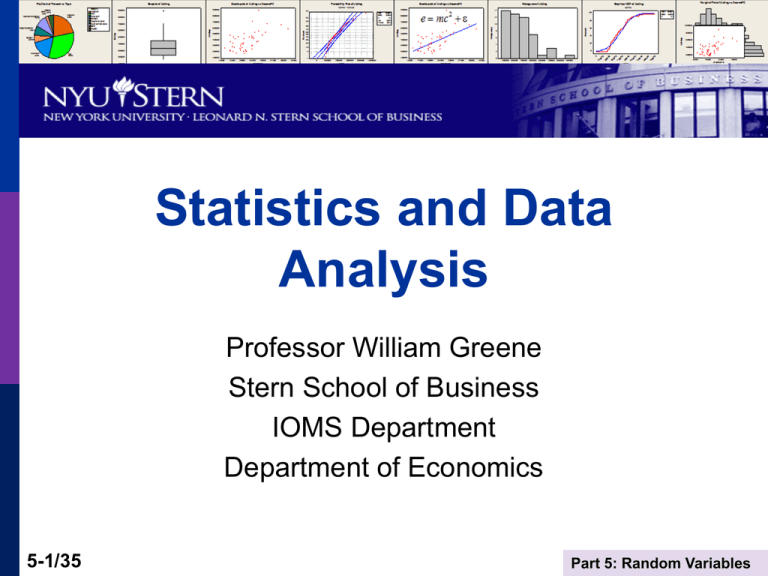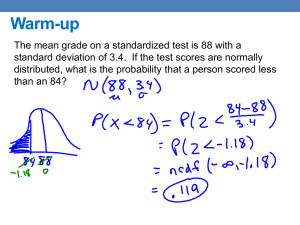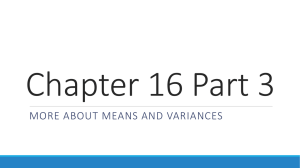Notes 5: Random Variables
advertisement

Statistics and Data Analysis Professor William Greene Stern School of Business IOMS Department Department of Economics 5-1/35 Part 5: Random Variables Statistics and Data Analysis Part 5 – Random Variables 5-2/35 Part 5: Random Variables Random Variable Using random variables to organize the information about a random occurrence. Random Variable: A variable that will take a value assigned to it by the outcome of a random experiment. Realization of a random variable: The outcome of the experiment after it occurs. The value that is assigned to the random variable is the realization. X = the variable, x = the outcome 5-3/35 Part 5: Random Variables Types of Random Variables Discrete: Takes integer values Continuous: A measurement. 5-4/35 Binary: Will an individual default (X=1) or not (X=0)? Finite: How many female children in families with 4 children; values = 0,1,2,3,4 Finite: How many eggs in a box of 12 are cracked? Infinite: How many people will catch a certain disease per year in a given population? Values = 0,1,2,3,… (How can the number be infinite? It is a model.) How long will a light bulb last? Values X = 0 to ∞ How do we describe the distribution of biological measurements? Measures of intellectual performance Part 5: Random Variables Modeling Fair Isaacs: A Binary Random Variable Sample of Applicants for a Credit Card (November, 1992) Experiment = One randomly picked application. Let X = 0 if Rejected Let X = 1 if Accepted Rejected 5-5/35 Approved X is DISCRETE (Binary). This is called a Bernoulli random variable. Part 5: Random Variables The Random Variable Lenders Are Really Interested In Is Default Of 10,499 people whose application was accepted, 996 (9.49%) defaulted on their credit account (loan). We let X denote the behavior of a credit card recipient. X = 0 if no default X = 1 if default This is a crucial variable for a lender. They spend endless resources trying to learn more about it. 5-6/35 Part 5: Random Variables 5-7/35 Part 5: Random Variables Distribution Over a Count Of 13,444 Applications, 2,561 had at least one derogatory report in the previous 12 months. Let X = the number of reports for individuals who have at least 1. X = 1,2,…,>10. X is a discrete random variable. (There are also about 9,500 individuals in this data set who had X=0.) 5-8/35 Part 5: Random Variables Discrete Random Variable? Response (0 to 10) to the question: How satisfied are you with your health right now? Experiment = the response of an individual drawn at random. Let X = their response to the question. X = 0,1,…,10 This is a DISCRETE random variable, but it is not a count. Do women answer systematically differently from men? 5-9/35 Part 5: Random Variables Continuous Variable – Light Bulb Lifetimes Probability for a specific value is 0. Probabilities are defined over intervals, such as P(1000 < Lifetime < 2500). Needs calculus. 5-10/35 Part 5: Random Variables Lightbulb Lifetimes Distribution of T = the lifetime of the bulb. 10,000 Hours? Philips DuraMax Long Life “Lasts 1 Year” … “Life 1000 Hours.” Exactly? 5-11/35 Part 5: Random Variables Probability Distribution Range of the random variable = the set of values it can take Discrete: A set of integers. May be finite or infinite Continuous: A range of values Probability distribution: Probabilities associated with values in the range. 5-12/35 Part 5: Random Variables Bernoulli Random Variable Probability Distribution P(X=0) P(X=1) 0.5556 0.4444 Experiment = A randomly picked application. Let X = 0 if Rejected Let X = 1 if Accepted The range of X is [0,1] Reject 5-13/35 Approve Part 5: Random Variables Probability Distribution over Derogatory Reports Derogatory Reports X P(X=x) 1 .5100 2 .2085 3 .0953 4 .0547 5 .0430 6 .0226 7 .0148 8 .0125 9 .0109 10 .0277 5-14/35 Part 5: Random Variables Notation 5-15/35 Probability distribution = probabilities assigned to outcomes. P(X=x) or P(Y=y) is common. Probability function = PX(x). Sometimes called the density function Cumulative probability is Prob(X < x) for the specific X. Part 5: Random Variables Cumulative Probability Derogatory Reports X P(X=x) P(X<x) 1 .5100 .5100 2 .2085 .7185 3 .0953 .8138 4 .0547 .8685 5 .0430 .9115 6 .0226 .9341 7 .0148 .9489 8 .0125 .9614 9 .0109 .9723 10 .0277 1.0000 The item marked 10 is actually 10 or more. 5-16/35 Part 5: Random Variables Rules for Probabilities 1. 0 < P(x) < 1 (Valid probabilities) 2. x all possible outcomes P(x) 1 3. For different values of x, say A and B, Prob(X=A or X=B) = P(A) + P(B) 5-17/35 Part 5: Random Variables Probabilities Derogatory Reports X P(X=x) P(X<x) 1 .5100 .5100 2 .2085 .7185 3 .0953 .8138 4 .0547 .8685 5 .0430 .9115 6 .0226 .9341 7 .0148 .9489 8 .0125 .9614 9 .0109 .9723 10 .0277 1.0000 5-18/35 P(a < x < b) = P(a)+P(a+1)+…+P(b) E.g., P(5 < Derogs < 8) = .0430 + .0226 + .0148 + .0125 = .0929 P(a < x < b) = P(x < b) – P(x < a-1) E.g., P(5 < Derogs < 8) = P(Derogs < 8) – P(Derogs < 4) = .9614 - .8685 = .0929 Part 5: Random Variables Mean of a Random Variable Average outcome; outcomes weighted by probabilities (likelihood) DenotedE[X] = i = all outcomes P(X xi ) xi Typical value Usually not equal to a value that the random variable actually takes. E.g., the average family size in the U.S. is 1.4 children. Usually denoted E[X] = μ (mu) 5-19/35 Part 5: Random Variables Expected Value X = Derogs x P(X=x) 1 .5100 2 .2085 3 .0953 4 .0547 5 .0430 6 .0226 7 .0148 8 .0125 9 .0109 10 .0277 μ=2.361 E[X] = 1(.5100) + 2(.2085) + 3(.0953) + … + 10(.0277) = 2.3610 5-20/35 Part 5: Random Variables Expected Payoffs are Expected Values of Random Variables 18 Red numbers 18 Black numbers 2 Green numbers (0,00) 5-21/35 Bet $1 on a number If it comes up, win $35. If not, lose the $1 The amount won is the random variable: Win = -1 P(-1) = 37/38 +35 P(+35) = 1/38 E[Win] = (-1)(37/38) + (+35)(1/38) = -0.053 = -5.3 cents (familiar). Part 5: Random Variables Buy a Product Warranty? Should you buy a $20 replacement warranty on a $47.99 appliance? What are the considerations? Probability of product failure = P (?) Expected value of the insurance = -$20 + P*$47.99 < 0 if P < 20/47.99. 5-22/35 Part 5: Random Variables Median of a Random Variable The median of X is the value x such that Prob(X < x) = .5. For a continuous variable, we will find this using calculus. For a discrete value, Prob(X < M+1) > .5 and Prob(X < M-1) < .5 X 0 1 2 3 4 5 6 7 8 9 10 Prob(X=x) Prob(X < x) .0164 .0164 .0093 .0257 .0235 .0492 .0429 .0921 .0509 .1430 .1549 .2979 .0926 .3905 .1548 .5453 .2259 .7712 .1120 .8832 .1168 1.0000 Mean (6.8) Median (7) Health Satisfaction Sample Proportions. 5-23/35 Part 5: Random Variables Measuring the “Spread” of the Random Outcomes Derogatory Reports X P(X=x) 1 .5100 2 .2085 3 .0953 4 .0547 5 .0430 6 .0226 7 .0148 8 .0125 9 .0109 10 .0277 μ=2.361 5-24/35 The range is 1 to 10, but values outside 1 to 5 are rather unlikely. Part 5: Random Variables Variance Variance = E[X – μ]2 = σ2 (sigma2) 2 2 P(X x )(x ) Compute i = all outcomes i i The square root is usually more useful. Standard deviation = σ Compute i = all outcomes P(X xi ) (xi )2 5-25/35 2 P(X x )x i = all outcomes i i 2 Part 5: Random Variables Variance Computation X = Derogatory Reports. μ = 2.361 x P(X=x) x-μ (x- μ)2 P(X=x)(x-μ)2 1 .5100 -1.361 1.85232 0.94468 2 .2085 -0.361 0.13032 0.02717 3 .0953 0.639 0.40832 0.03891 4 .0547 1.639 2.28632 0.14694 5 .0430 2.639 6.96432 0.29947 6 .0226 3.639 13.24232 0.29928 7 .0148 4.639 21.53032 0.31850 8 .0125 5.639 31.79832 0.39748 9 .0109 6.639 44.07632 0.48043 10 .0277 7.639 58.35432 1.61641 SUM 4.56928 5-26/35 σ2 = 4.56928 σ = 2.13759 Part 5: Random Variables Common Results for Random Variables Concentration of Probability What it means: For any random outcome, 5-27/35 For almost any random variable, 2/3 of the probability lies within μ ± 1σ For almost any random variable, 95% of the probability lies within μ ± 2σ For almost any random variable, more than 99.5% of the probability lies within μ ± 3σ An (observed) outcome more than one σ away from μ is somewhat unusual. One that is more than 2σ away is very unusual. One that is more than 3σ away from the mean is so unusual that it might be an outlier (a freak outcome). Part 5: Random Variables Outlier? 5-28/35 In the larger credit card data set, there was an individual who had 14 major derogatory reports in the year of observation. Is this “within the expected range” by the measure of the distribution? The person’s deviation is (14 – 2.361)/2.137 = 5.4 standard deviations above the mean. This person is very far outside the norm. Part 5: Random Variables Recall from day 2 of class Reliable Rules of Thumb 5-29/35 Almost always, 66% of the observations in a sample will lie in the range [mean+1 s.d. and mean – 1 s.d.] Almost always, 95% of the observations in a sample will lie in the range [mean+2 s.d. and mean – 2 s.d.] Almost always, 99.5% of the observations in a sample will lie in the range [mean+3 s.d. and mean – 3 s.d.] Part 5: Random Variables A Possibly Useful “Shortcut” E[X – μ]2 = E[X2] – μ2 = 5-30/35 2 2 P(X x )x μ i = all outcomes i i Part 5: Random Variables Application PartyPlanners plans parties each day, and must order supplies for the events. The number of requests for party plans varies day by day according to P(X=0) = .4 P(X=1) = .3 P(X=2) = .25 P(X=3) = .05 How many parties should they expect on a given day? E[X] = .4(0) + .3(1) + .25(2) + .05(3) = .95, or about 1. What are the variance and standard deviation? Var[X] = .4(02 )+ .3(12 ) + .25(22 ) + .05(3 2 ) -.952 = .8475. 0.8475 = 0.9206 If they plan for 1 party per day, it is rather likely that they will run out of materials since 2 is only 1.1 standard deviations above the mean. 5-31/35 Part 5: Random Variables Important Algebra Linear Translation: For the random variable X with mean E[X] = μ, if Y = a+bX, then E[Y] = a + bμ Scaling: For the random variable X with standard deviation σX, if Y = a+bX, then σY = |b| σX It is not necessary to transform the original data. 5-32/35 Part 5: Random Variables Example: Repair Costs 5-33/35 The number of repair orders per day at a body shop is distributed by: Repairs 0 1 2 3 4 Probability .1 .2 .35 .2 .15 Opening the shop costs $500 for any repairs. Two people each cost $100/repair to do the work. What are the mean and standard deviation of the number of repair orders? μ = 0(.1) + 1(.2) + 2(.35) + 3(.2) + 4(.15) = 2.10 2 2 2 2 2 2 2 σ = 0 (.1) + 1 (.2) + 2 (.35) + 3 (.2) + 4 (.15) – 2.1 = 1.39 σ = 1.179 What are the mean and standard deviation of the cost per day to run the shop? Cost = $500 + $100*(2)*(Number of Repairs) Mean = $500 + $200*(2.1) = $920/day Standard deviation = $200(1.179) = $235.80/day Part 5: Random Variables Summary 5-34/35 Random variables and random outcomes Outcome or sample space = range of the random variable Types of variables: discrete vs. continuous Probability distributions Probabilities Cumulative probabilities Rules for probabilities Moments Mean of a random variable Standard deviation of a random variable Part 5: Random Variables Application: Expected Profits and Risk You must decide how many copies of your self published novel to print . Based on market research, you believe the following distribution describes X, your likely sales (demand). x P(X=x) 25 .10 (Note: Sales are in thousands. Convert your final result to 40 .30 dollars after all computations are done by multiplying your 55 .45 final results by $1,000.) 70 .15 Printing costs are $1.25 per book. (It’s a small book.) The selling price will be $3.25. Any unsold books that you print must be discarded (at a loss of $2.00/copy). You must decide how many copies of the book to print, 25, 40, 55 or 70. (You are committed to one of these four – 0 is not an option.) A. What is the expected number of copies demanded. B. What is the standard deviation of the number of copies demanded. C. Which of the four print runs shown maximizes your expected profit? Compute all four. D. Which of the four print runs is least risky – i.e., minimizes the standard deviation of the profit (given the number printed). Compute all four. E. Based on C. and D., which of the four print runs seems best for you? 5-35/35 Part 5: Random Variables X = Sales (Demand) x P(X=x) 25,000 .10 40,000 .30 55,000 .45 70,000 .15 A. Expected Value = all values of x x P(X=x) = .1(25,000) + .3(40,000) + .45(55,000) + .15(70,000) = 49,750 5-36/35 Part 5: Random Variables B. Standard Deviation Get the Variance First 2 all values of x (x - E[x]) 2 P(X=x) = .1(25,000 - 49,750) 2 .3(40,000 - 49,750) 2 + .45(55,000 - 49,750) 2 + .15(70,000 - 49,750) 2 = 163,687,500 Standard Deviation = square root of variance. = 163,687,500 = 12,794.041 There is a shortcut 2 all values of x x 2 P(X=x) 2 2 all values of x (x - E[x]) 2 P(X=x) .1(25,0002 ) .3(40,000 2 ) + .45(55,0002 ) + .15(70,0002 ) - 49,750 2 = 163,687,500 = 5-37/35 Part 5: Random Variables x P(X=x) Revenue per book = $3.25 25,000 40,000 .10 .30 Cost per book = $1.25 Profit per book sold = $2.00/book 55,000 .45 70,000 .15 Expected Profit | Print Run = 25,000 is $2 25,000 = $50,000 (Demand is guaranteed to be at least 25,000) Expected Profit | Print Run = 40,000 is $2 .9 40,000 + .1 ($2 25,000 - $1.25 15,000) = $75,125 (If print 40,000, .9 chance sell all and .1 chance sell only 25,000) Expected Profit | Print Run = 55,000 is $2 .6 55,000 + .1 ($2 25,000 - $1.25 30,000) + .3 ($2 40, 000 $1.25 15, 000) = $85,625 Expected Profit | Print Run=70,000 is $2 .15 70,000 + .1 ($2 25,000 - $1.25 45,000) + .3 ($2 40, 000 $1.25 30000) + .45 ($2 55, 000 $1.25 15000) = $55,287,50 5-38/35 Part 5: Random Variables Expected Profit Given Print Run 5-39/35 Part 5: Random Variables Variances Print Run = 25,000. Variance = 0. Std. Dev. = 0 Demand will be at least 25,000. Print Run = 40,000. Variance = .1*[(2* 25000 1.25*15000) 75,125]2 .9*[(2* 40000) 75,125)]2 (if demand is only 25,000) (if demand is 40,000) Standard Deviation = square root = $14625 Print Run = 55,000. Variance = .1*[(2* 25000 1.25*30, 000) 85, 625]2 .3*[(2* 40000) 1.25*15, 000) 85, 625] + .6*[(2*55, 000 85,625] (if demand is only 25,000) (if demand is 40,000) (if demand is 55,000) Standard Deviation = square root = $32,702.49 Print Run = 70,000. Variance = .1* [(2* 25000 1.25* 45000) 55, 287.5]2 (if demand is only 25,000) .3* [(2* 40000 1.25*30, 000) 55, 287.5]2 + (if demand is 40,000) .45*[(2*55, 000 1.25*15, 000) 55, 287.5]2 + (if demand is 55,000) .15*[2*70, 000 5-40/35 55, 287.5]2 (if demand is 70,000) Standard Deviation = square root = $35,572.84 Part 5: Random Variables Run=70,000 Run=55,000 Run=40,000 Run=25,000 5-41/35 Part 5: Random Variables Run=70,000 Run=55,000 Run=40,000 Run=25,000 5-42/35 Part 5: Random Variables Run=70,000 ? Run=55,000 Run=40,000 Run=25,000 5-43/35 Part 5: Random Variables








